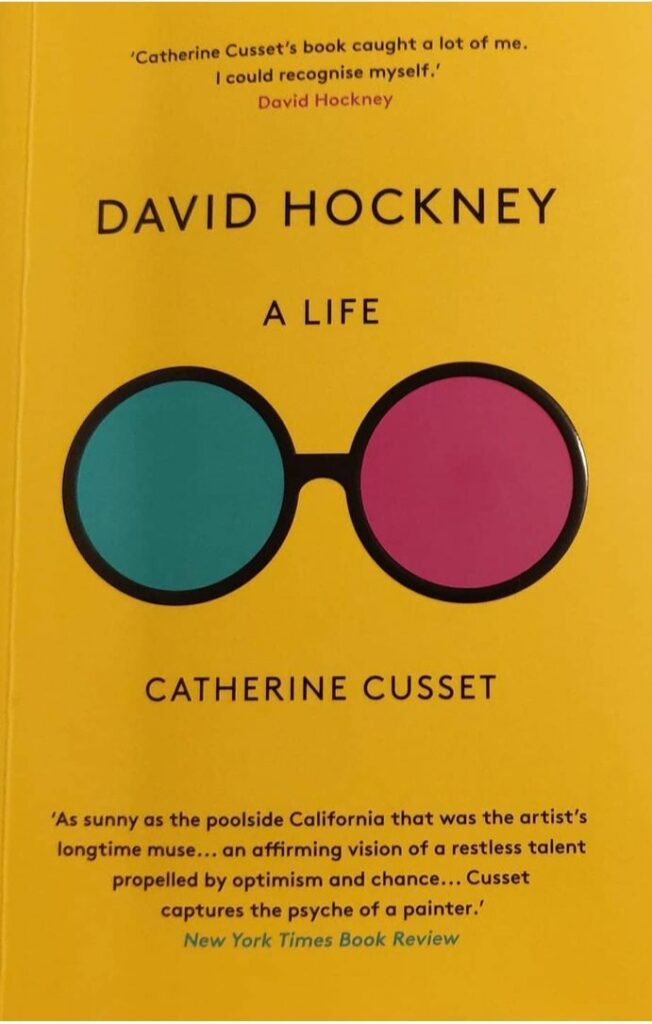David Hockney A Life arrived on a rainy November afternoon. Its bright yellow cover with pink and blue circles contrasted everything about the dreary season in which it landed. Some book covers exude a strength, a confidence that announces the book before a single page is turned. More often than not, a front is nothing but, well, a front. However, the energy in Cusset’s portrait of Hockney, in his white suit and bleached hair, matches the strength and simplicity of the cover. Although this work is based on the life of David Hockney, Cusset assures us that this is a novelistic account where she has unified and threaded his life story with artistic license.

David Hockney’s talents unshackle him from his happy yet humble Bradford origins. As a young artist with a strong internal compass, he decides to paint only what matters to him. His artistic life follows a linear trajectory that doesn’t bow to the tastes of the modern art theorists or critics, and leads him to fame and fortune, a fairy-tale life to anyone on the outside looking in. If this was a work of pure fiction, would anyone believe that the life of a young, working-class artist from northern England could have progressed with such ease?
Hockney’s life marches along in a steady progression. Cusset doesn’t loop back; no elements of his childhood or adolescence return to haunt him as an adult. A close friend, Ann, describes Hockney as an island, a self-winding clock. David, however, doesn’t consider himself a self-winding clock; he needs to be surrounded by friends, who like many in the gay community, become his family. The character of Hockney as portrayed by Cusset, through his steady stream of successes, lovers, old and new friends, his migrations to and from California, his switching through different mediums and perspectives, suggests that he’s probably as close as a human can come to being a self-winding clock.
Although he laughs off critics and pins their work to his wall in defiance, their words sink to his bedrock. On weak moments, their opinions threaten to become gospel. Luckily, this never seems to last long. Nights spent lying awake in this story are few and far between. With the constant houseguests and dinner parties, drink and drugs, a traditional night’s sleep is not something that appears as a feature of the book until much later in his life, after he has suffered his second stroke. Very little of this story lies in wait for anything.
Towards the end of the book, David’s beloved sister says that she thinks the space around us is God. There is a godliness in the space this small book allows for the preservation of Hockney’s dignity. Despite narrating some of the most harrowing experiences in Hockney’s life: the loss of all his close friends to AIDS or pancreatic cancer, the loss of his parents, and the loss of his hearing, at his lowest moments, Hockney’s story keeps ploughing ahead. With a change of scene, a change of tools, an embrace of technology, a return to his canvas, he continues to find the beauty in his surroundings, whether it’s a billboard in Los Angeles or a hawthorn bloom in Yorkshire. Despite the fact that there are intimate details in the book such as his loss of erectile function as he progresses into his seventies, or how much he suffered when his first and probably greatest love, Peter, breaks off their relationship, Cusset writes scenes as if she’s working with watercolours. She gives, what seems like equal treatment to all parts of his life.
Hockney lives a charmed life. Despite all the odds, he emerged out of nowhere Bradford to become a prominent figure in the global art world. Despite living through the AIDs epidemic, losing many around him, he remained unscathed. Although his health has plagued him at times, he has recovered. Despite his deafness and progressing age, he continues to see the world anew.
This swift, bright, active text, is a winter tonic. David Hockney A Life, written by Catherine Cusset, is the literary equivalent to a Hockney painting.